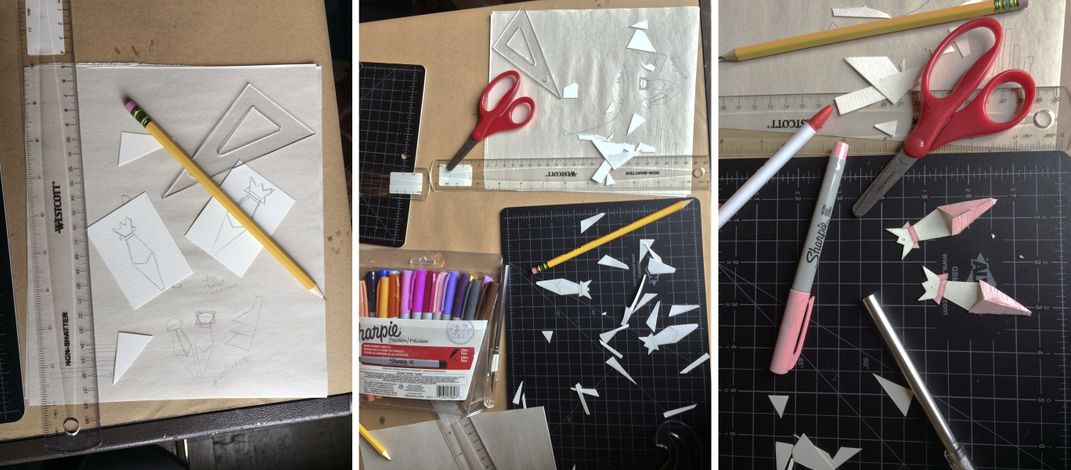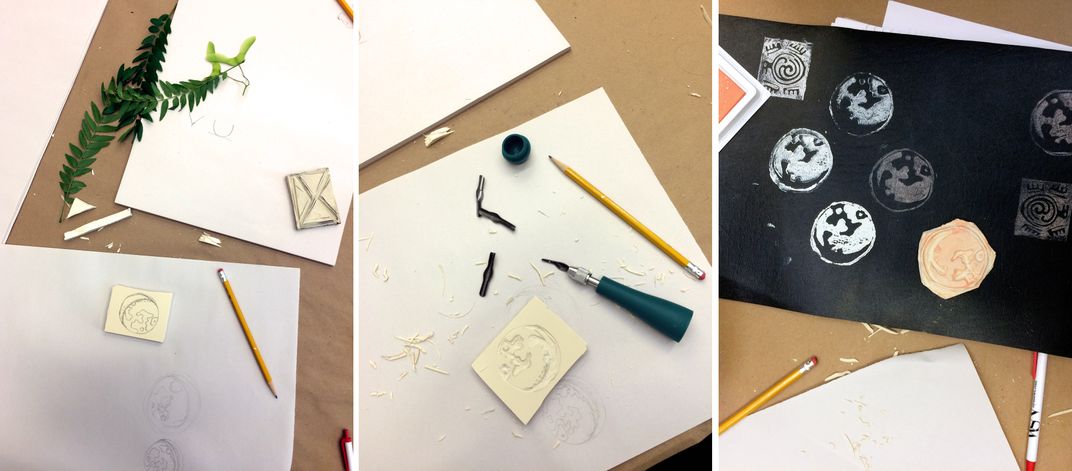NATIONAL MUSEUM OF THE AMERICAN INDIAN
Makers + Mentors: Hands-on with leaders of Native fashion
From our museum in New York: Native designers, artists, and entrepreneurs who are making their mark on fashion take a day off to work with young people hoping to become a part of that world. Some pointers? Communicate, collaborate, and support each other. Expect creative fields to be an ongoing struggle—keep working! And remember, perfection is not the goal.
/https://tf-cmsv2-smithsonianmag-media.s3.amazonaws.com/blogging/featured/Makers__Mentors.jpg)
As an intern at the National Museum of the American Indian in New York this summer, I had the pleasure of attending last week’s Makers + Mentors event, a series of workshops and conversations with Native designers, artists, and business owners who make their mark on the world of fashion. The day-long program, inspired by the exhibition Native Fashion Now, on view in New York through September 4, centered around providing guidance and support to young—ages 14 through 24—aspiring designers and artists interested in careers in fashion or design.
At the museum’s welcome and introduction of some of the makers and mentors, I spoke with a few of the young people taking part in the event, asking them what they were most excited to do that day and what inspired them as artists. Two high school students, who told me they are inspired the most by the show Project Runway and the street-wear they see on the sidewalks of the Bronx, are both planning to go to medical school. They emphasized, however, that they want to keep designing, either through a minor in fashion or by dedicating free time to art, even as they pursue careers in medicine. One college student who dreams of one day designing costumes for movies like Beauty and the Beast said that she is constantly assessing the historical accuracy of clothing she sees in films, and that historical fashion is one of her biggest inspirations. I even had a chance to speak quickly with one of the mentors, fashion model Jade Willoughby (Ojibwe). Gesturing to the two younger girls sitting with her at the table, she told me that she is inspired by “the passion of other people in this industry—the passion that drives designers’ dreams into reality.”
Next, I attended Place + Identity, a materials lab led by Courtney M. Leonard (Shinnecock). The lab was located in the Coat Room, or “Camel Room,” of the Alexander Hamilton U.S. Customs house, and the room's ornate air (its ceiling is painted with camels) provided a dynamic contrast to Courtney’s down-to-earth approach to success.
Courtney, a multidisciplinary artist and filmmaker, gave us a peek into her creative process, showing us photos of the subway, skyscrapers, and sea creatures—all inspirations to her. I admire her apparent ability to find patterns and structures in nearly anything, and I wish I could be as creatively unafraid as she is with her work. She showed us how she used landscape and location to begin creating a piece of clothing or jewelry, saying that “the landscape that is around us is the culture, the being, and the essence.” She also spoke about her attachment to Long Island’s Shinnecock Nation, and how she used images like the thunderbird from Algonquin mythology to find fresh, unique patterns for her work.

We all then began designing and creating mock-ups of structural jewelry. Courtney encouraged us to start with simple shapes we see around us and find a pattern from there. Here is the set of earrings I created, inspired by the pointed toes of the businesswomen’s shoes I see on the subway every morning, as well as by ballet shoes, and suggesting the shape of a fish.
During the lunch break, I spoke with a few girls who are students at a fashion high school in New York. Their style inspirations range from their parents to the clothes of the ’70s, Ariana Grande, and flower gardens. When asked why she is passionate about design, one student replied that “from a piece of fabric you can create anything—it’s extremely expressive.” Another gave me her perspective on the importance of supporting Native artists, saying that non-Native designers can study Native cultures, but they do not have the same first-hand experience with those cultures that gives Native designers such a unique and powerful artistic perspective, and the authority and knowledge to use aspects of their cultures in a way that does not take advantage of Native communities.
At my next lab, textile designer and performance artist Maria Hupfield (Wasauksing First Nation) taught our group how to sketch and carve out our own rubber stamps, which could be transferred onto fabric to create an ink pattern. I was amazed by the creativity of the people around me—no one in the group had made stamps before, yet most of the students seemed right at home, experimenting with blank space and different materials to stamp on. Maria had a very calm approach to her work and spent most of her time visiting people who seemed to be struggling and reminding them that perfection was not the goal.
I think the lab was so exciting because we were able to create something completely our own that we could transfer onto almost any surface. One girl carved out her name in the rubber and begged her friends to let her stamp it onto their backs. Here’s the moon-shaped stamp I created, and a few patterns I did on leather. I tried to create the effect of a shadow over part of the moon, but I didn’t really achieve this. (Maria very kindly told me it was great.)

I was lucky to attend the tour of Native Fashion Now guided by fashion designer Patricia Michaels (Taos Pueblo). It’s hard to write briefly about the fascinating collection of pieces she spoke about, but I will say that I was amazed that she knew more than half of the featured designers personally. Patricia stressed that the Native design community is a tight one, and that many of the artists are in constant communication, creating a vital web of support and collaboration that drives their success.
To wrap up the day, fashion and textile historian Regan Loggans moderated a conversational panel discussion. Patricia Michaels, Niio Perkins (Haudenosaunee), Loren Aragon (Acoma Pueblo), Jared Yazzie (Diné [Navajo]), Jade Willoughby (Whitesand First Nation), and editorial hair stylist Amy Farid (Osage) shared their thoughts on Native design, inspiration, and personal responses to struggle. I know it’s a cliché to say that their stories were inspiring, but they truly were. As an English student who sees fashion simply as a side hobby, I found myself considering what impact I might be able to make on the fashion world in the future, and how I could help support the compelling work of Native designers and artists. The panelists especially emphasized that they had to fight to find a place for themselves in an industry that is not kind to newcomers, or outsiders. I wrote down a few of my favorite quotes, and I’ll share them here to wind up this post:
“I think my authentic self is still trying to figure out where I sit in the world.” —Jared Yazzie (Diné [Navajo]), on his personal relationship with the struggle to self-define his work
“Don’t tell me how to be Native. I am Native American. That’s what makes it Native.” —Patricia Michaels (Taos Pueblo), in response to people who say that her designs are not truly Native
“Everything is at our fingertips. We have no excuses that we shouldn’t be where we want to be.” —Patricia Michaels, on the responsibility and empowerment that modern technology gives to contemporary artists
“There’s a story behind what we present. There’s meaning behind what we have in our work.” —Loren Aragon (Acoma Pueblo), on the authenticity of Native design
“I have to stand my ground most days, but this is the work I want to do.” —Jared Yazzie, explaining how he deals with constant criticism
“We’re all human beings. At the end of the day, we fit in everywhere.” —Amy Farid (Osage), in response to the question, Where do Native designers belong in the world of fashion?
“No matter how far you go in life, you will always come back to your people. In this life or the next.” —Jade Willoughby (Whitesand First Nation), on the importance of remembering the place you came from
Thanks for reading! I strongly recommend you check out these designers. Exploring their work really gave me a new perspective on the ever-expanding and changing role of Native fashion in the chaos of today.
